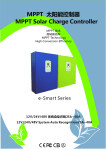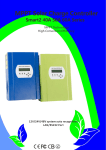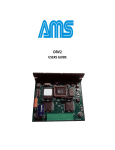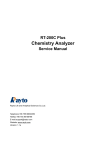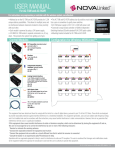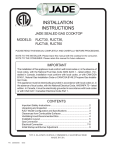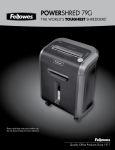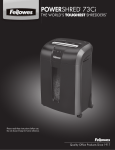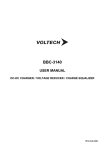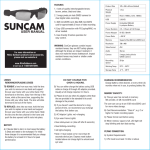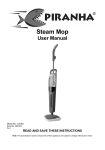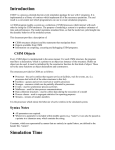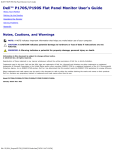Download CSD205H
Transcript
™ CSD205H MICROSTEPPING DRIVE MODULE USER’S MANUAL CSIM Inc. “Control System In Motion” September 2002 TABLE OF CONTENTS SECTION 1: INTRODUCTION ………………………………………… 1.1 Overview ………………………………...………… 1.2 Product Features …………………………………... 1.3 Electrical Specifications …………………………….. 2 2 2 2 SECTION 2: EXPRESS START UP PROCEDURE ………………….. 3 SECTION 3: TERMINAL LOCATIONS AND ASSIGNMENTS .......… 3.1 Motor connection ………………………………….... 3.2 Power Input ……………………………………….. 3.3 Control Signal Input …………………….……….. 4 4 5 5 SECTION 4: DIP SWITCH SETTINGS …………………...………… 7 SECTION 5: OPERATION INSTRUCTION ......................................... 5.1 Motor Compatibility …………………………...… 5.2 Supply Voltage …………………………………… 5.3 Current Setting …………………….…………… 5.4 Current Damping Function ……………..………… 5.5 Automatic Current reduction ………………..……… 8 8 8 9 9 9 SECTION 6: TROUBLE SHOOTING ……..………………………… 6.1 In General ………………….……………………… 6.2 Chick List ….……………………………………… 10 10 10 Control System In Motion Page 1 CSIM Inc. SECTION 1: 1.1 INTRODUCTION Overview The CSD205H Microstepping Drive Module is a high performance microstepping driver. It can provide an output current up to 6(rms) amperes per phase to operate a step motor at 40,000 microsteps per revolution. 1.2 Product Features z Single power supply input z High and wide range input voltage (24 to 75Vdc) z Switch selectable current level from 3 to 6 Amps rms (4.2 to 8.4 Amps peak) z Switch selectable microstepping resolution from 400 to 40,000 microsteps z z z z z z 1.3 per revolution Automatic idle current reduction Optically isolated inputs Input signals use Pulse/Direction mode or CW/CCW pulse mode is selectable by a switch Selectable current damping function to reduces resonant vibration and noise at low speed Motor clockwise or counterclockwise rotate can be swapped by a switch All input signal terminals are equipped with convenient Snap-In head Electrical Specifications ITEM Input power Min Typ Max 24Vdc 65Vdc 75Vdc Output current per phase 3 Amps RMS 4.2 Amps Peak 6 Amps RMS 8.4 Amps Peak Microstep resolution 400 steps/revolution 40,000 steps/revolution Maximum input pulse rate Control System In Motion 1,000,000 pulses/sec Page 2 CSIM Inc. SETCTION 2: EXPRESS START UP PROCEDURE The following instructions define the minimum procedures necessary to make the CSD205H microstepping drive module operational. 1. Check the motor used is suitable to the CSD205H. Please refer to the section 5.1 about how to select a motor. 2. Set the correct current level for the motor as described in section 4 and section 5.3. While the current setting is more than 3 amps, heat sinking may be required to maintain case temperature below +70°C. 3. 4. 5. 6. 7. 8. Select the appropriate step resolution and set the switches as described in section 4. Connect the motor following the “Motor Connections” description in section 3.1. Connect the control input signal as described in section 3.3. Connect the power source to the DC input terminal as described in section 3.2. The indicate LED should turn on immediately after power on. The motor will be locked by a holding torque. Send the pulses signal input to driver, the motor should rotate according to the pulse rate and the step resolution set. If the motor’s rotation direction is improperly, swap the dip switch #4 as description in section4 will change it. Caution: Always disconnect the power to the module before connecting or disconnecting the motor leads. Failure to do this will result in a shock and may damage the driver. Control System In Motion Page 3 CSIM Inc. SECTION 3: 3.1 TERMINAL LOCATIONS AND ASSIGNMENTS Motor Connection The motor connections are made via the 4-terminal Head JP2. Table 3.1 JP2 Pin 4 Assignment Phase B- 3 Phase B+ 2 Phase A- 1 Phase A+ The CSD205H is a Bipolar driver. It could work equally well with both Bipolar motors, i.e. 4 and 8 lead motors and Unipolar motors, i.e. 6 lead center tapped motors. Figure 3.1 Motor connection Control System In Motion Page 4 CSIM Inc. 3.2 Power Input The DC input power is connected to head JP1. Please be aware that pin+ is the power supply plus(+) connection and pin- is the power supply minus(-) connection. Connecting the pins incorrectly will not damage the CSD205H because of the built-in protect circuit, but the CSD205H will not operate. An unregulated power supply coupled with a filter capacitor is preferable. A switching regulated power supply may not be suitable for use with the CSD205H. Please refer to section5.2 about the supply voltage. 3.3 CONTROL SIGNAL INPUT The control signal input is made via the 4-terminal Head JP3. Table 3.2 JP3 Pin Pin Name Function Description 1 OPTO This terminal should be connected to +5Vdc supplied power for the opto-isolators. 2 Pulse/CW In pulse mode (SW #8 On) A high to low transition on this terminal will advances the motor one step. The direction is determined by Pin 3 state. In CW/CCW mode A high to low transition on this (SW #8 Off) terminal will advance the motor one step in clockwise direction. 3 OPTO This terminal should be connected to +5Vdc supplied power for the opto-isolators. 4 DIR/CCW In pulse mode (SW #8 On) When the signal is high, motor rotation will be clockwise. Rotation will be counterclockwise when the signal is low. In CW/CCW mode A high to low transition on this (SW #8 Off) terminal will advance the motor one step in counterclockwise direction. 5 OPTO This terminal should be connected to +5Vdc supplied power for the opto-isolators. 6 Hold Off When the signal is low, output current will be zero. There will be no holding torque at this state. Control System In Motion Page 5 CSIM Inc. CSD205H JP3 330 ohms PIN 1 PIN 2 330 ohms PIN 3 PIN 4 330 ohms PIN 5 PIN 6 Figure 3.2 Input Interface Circuit 12Vdc 550 Ohms 1 JP3 2 same as pin 1 same as pin 2 same as pin 1 same as pin 2 3 CSD205H 4 5 6 5Vdc 1 JP3 2 same as pin 1 3 same as pin 2 4 CSD205H same as pin 1 5 same as pin 2 6 5Vdc 1 JP3 2 U2A 1 2 7406 same as pin 1 3 same as pin 2 4 same as pin 1 same as pin 2 CSD205H 5 6 Figure 3.3 Suggested Methods for Input Control System In Motion Page 6 CSIM Inc. SECTION 4: DIP SWITCH SETTINGS Table 4.1 Dip Switch Channel No. #1-2 #3 #4 #5-7 #8 Function Set Output Current Set Current Damping Select Switch Position Sw1 Sw2 Output Current RMS Peak On On 6 Amps 8.4Amps Off On 5 Amps 7 Amps On Off 4 Amps 5.6 Amps Off Off 3 Amps 4.2 Amps On Enable Current Damping Off Disable Current Damping Description Refer to section 5.3 Refer to section 5.4 Chang Motor Switch On/Off will alternate the Rotate motor’s default rotate direction. Direction Select Microstep Resolution Select Input Signal Mode Control System In Motion Sw5 Sw6 Sw7 On On On Off On On 20,000 On Off On 10,000 Off Off On 5,000 On On Off 2,000 Off On Off 1,600 On Off Off 1,000 Off Off Off 400 On Microsteps Per The value list Resolution is based on to use 1.8°Step 40,000 Motor CW/CCW Pulse Mode Off Pulse/Direction Mode Page 7 CSIM Inc. SETCTION 5: OPERATION INSTRUCTIONS 5.1 Motor Selection The CSD205H microstepping drive module is a current controlled driver to maintain a given set of motor current. It chops the voltage using a constant chopping frequency and varying duty cycle. This characteristic is directly related to the motor’s winding resistance and inductance. To avoid improperly chopping, it is necessary to choose a motor with a low winding resistance. In fact, a motor’s winding resistance is usually related to its current rating. Lower winding resistance means higher current rating. In this case, selecting the motor with current rating approximate to but no more than 5 Amps and with the lowest possible winding resistance is a good practice. Since the CSD205H microstepping drive module is a constant current driver, it is not necessary to use a motor that is rated at the same voltage as the supply voltage. 5.2 Supply Voltage The CSD205H microstepping drive module works with a wide range of input voltage from 24Vdc to 75Vdc. For better performance, however, use of higher voltage is recommended. The higher the voltage used, the faster the current can flow through the motor coils. This means the higher step rate. However care should be taken not to exceed the maximum voltage 75Vdc. An unregulated supply similar to that shown in Figure 5.1 is preferable. If a regulated supply is used, it must be a linear regulated supply and should be capable of operating with added filter capacitor. A switching regulated supply is not recommended. F1 AC110V T1 5 AC48V 1 1 FUSE 5A 4 8 2 - + 4 DC65V TRANSFORMER 240VA C1 10,000U/100V 3 D1 BRIDGE Figure 5.1 Control System In Motion Page 8 CSIM Inc. 5.3 Current Setting The CSD205H can provide 4 different current levels from 3 to 6 Amps. This is selected by the dip switch #1 to #2. Please refer to the Table 4.1. It is important to set the current level according to the motor’s current rating. A lower current setting will reduce the motor’s torque and speed performance. On the other hand, a higher current setting will cause the motor over heating. 5.4 Current Damping Function The CSD205H has a selectable current damping function. Setting the dip switch #3 to “On” position will reduce output current at low speed. This could reduce the motor’s resonant vibration and noise. However it may also reduces the motor’s low speed output torque. Setting the current damping “On” will not affect the high speed performance 5.5 AUTOMATIC CURRENT REDUCTION The CSD205H microstepping drive module will automatically reduce the output current to the motor while in idle state. The reduction occurs approximately 1 second after the last falling edge of the step pulse input. The CSD205H microstepping drive module will reduce the current to a 50% level Control System In Motion Page 9 CSIM Inc. SECTION 6: TROUBLESHOOTING 6.1 In General If installation and operating instructions have been followed carefully, the CSD205H microstepping drive module should operate correctly. In case the motor fails to rotate properly, the following check list will be helpful to locate and correct the problem. z Check all installation wiring carefully for wiring errors or poor connections. z Check to see that a proper voltage level (i.e. 24Vdc – 75Vdc) is being supplied. z Be sure that the motor’s leads are correctly connected to CSD205H microstepping drive module’s corresponding phase terminals. 6.2 Check List SYMPTON Indicator LED not lit Motor has no holding torque with power applied to the driver PROBLEM POSSIBLE SOLUTION Without input voltage or the power polarity is inversed Connect input voltage properly. The fuse is burned Replace a new fuse of 6 Amps rating. But if the fuse is still burned, don’t try this again. Motor is cross wired with Reconnect motor windings to each winding connected to the corresponding phase both Phase A and Phase B. terminal. “Hold Off” Input is enabled. “Hold Off” input (Pin4 of JP4) should be high or not connect. Motor has holding Step pulse input is absent. Check pulse input with an torque but can not oscilloscope. rotate. If the pulse train is absent, troubleshoot stepping source and interconnection wiring. Only one motor phase has Check phase current in both been driven. phases by placing an ammeter in series with each winding. If not present, check for open circuit in motor phase winding by measure the resistance. Start speed is too high Control System In Motion Page 10 Lower the start speed. CSIM Inc. SYMPTON Motor misses steps. Motor operation is rough or erratic PROBLEM POSSIBLE SOLUTION Output current level setting Set current to higher level. is too low Improper use ” Current Damping” Disable “Current Damping” Speed or acceleration is too high. Lower the speed. Operation is on resonance Change work speed. region Use “ Current Damping” function Microstep resolution setting is improper (For instance 400 steps per revolution at low speed) Adjust microstep resolution to a higher value. Output current level setting Set current to a lower level. is too high. CSIM Inc. “Control System In Motion” Control System In Motion Page 11 CSIM Inc.













